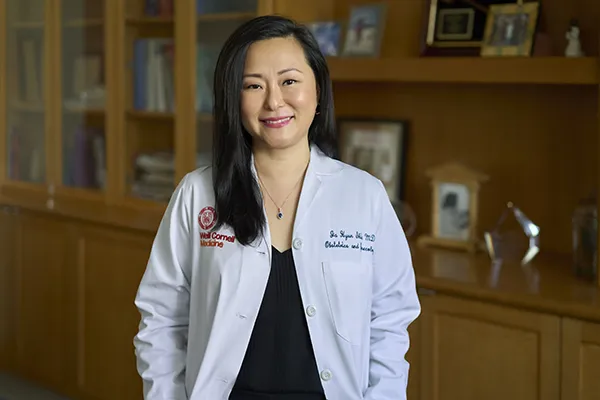In April 2020, just weeks after COVID-19 was declared a national emergency, Dr. Ja Hyun Shin began her role as Director of Minimally Invasive Gynecologic Surgery at NewYork-Presbyterian/Weill Cornell Medicine. With elective surgeries suspended, Dr. Shin and her team dove instead into laying the groundwork for new patient programs to treat a full range of gynecological conditions, from uterine fibroids to endometriosis, in the least invasive way possible.
“During that time, we formulated our ideas for establishing truly comprehensive programs, meaning that we would work very closely with a network of specialists to provide multidisciplinary care,” says Dr. Shin, who is an expert in advanced laparoscopic and robotic surgeries. A patient’s care team could include gynecologists, minimally invasive surgeons, interventional radiologists, reproductive endocrinologists, pelvic floor disorder experts, physical medicine and rehabilitation providers, pain management experts and more, depending on their condition and personal health goals.
Today, under the leadership of Dr. Shin, the Fibroid and Adenomyosis Program and the Endometriosis and Pelvic Pain Program provide patients with individualized care for conditions that can be common — up to 80% of women have fibroids, for instance — but often complex to diagnose and treat. “Patients walk away from our appointments feeling as though they’ve had comprehensive counseling,” says Dr. Shin, noting that patients are consulted on surgical and nonsurgical forms of treatment. “They have increased confidence that they understand what’s going on in their bodies and the decisions that need to be made with their doctors.”
Dr. Shin sat down with NYP Advances to discuss her vision for the programs and their impact thus far.
When did you know you wanted to pursue OB-GYN, and specifically gynecologic surgery, as your specialty?
I knew early on with my first case as an intern in residency. I performed a hysteroscopy for a polyp, which is a minor procedure but appropriate for an intern to scrub into. The case was so simple, but to me, it was fascinating. I really enjoyed the whole process of learning about the patient and her disease, reading the radiology report and seeing the images, and then visualizing with a camera the pathology that was the culprit of her symptoms. Then there was the incredible satisfaction of removing the problem. The part about surgery that I find most rewarding is that you can improve the health and quality of life for someone so immediately. That experience and the rest of my residency really cemented that the operating room was where I belonged.
Having doctors who can provide such a high level of care and a thorough explanation of their options gives patients a sense of empowerment.





